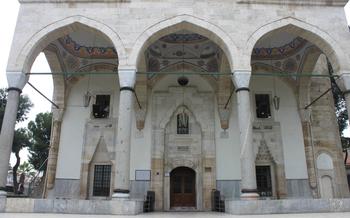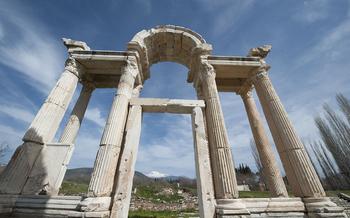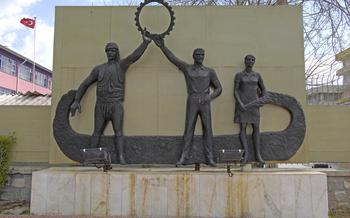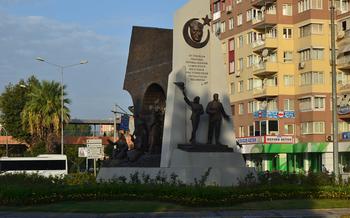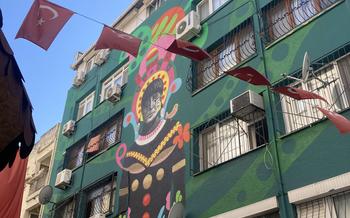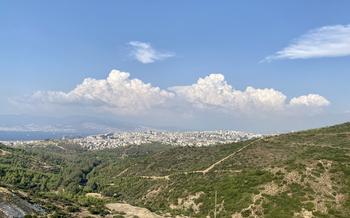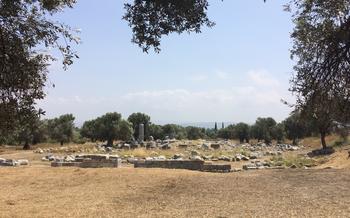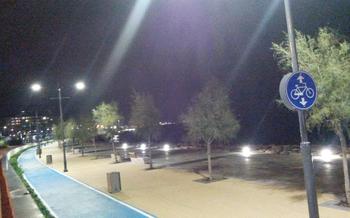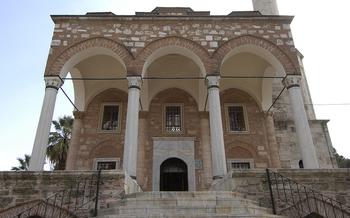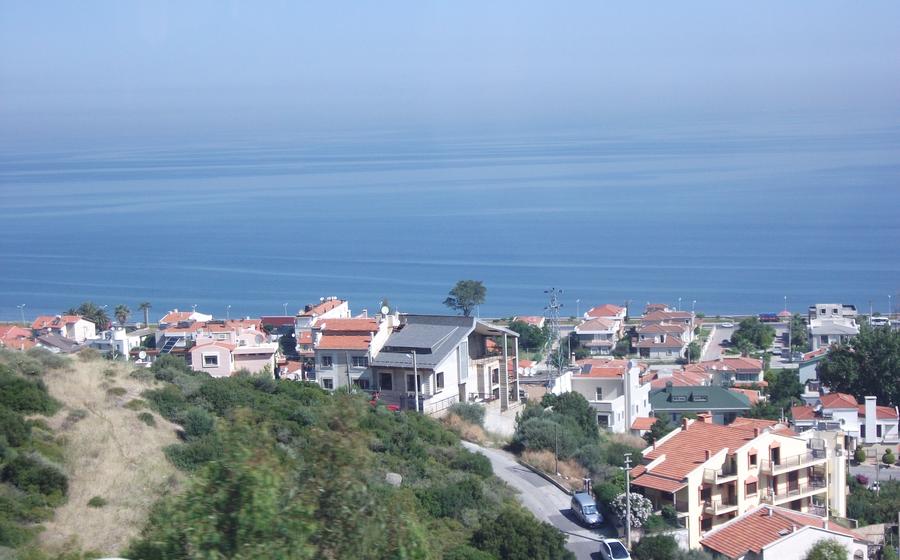
Didyma Ancient City
- Didyma Ancient City: An Overview
- The Temple of Apollo
- The Sacred Way
- The Theater
- The Stadium
- The Agora
- The Necropolis
- The Museum of Didyma
- Festivals and Events
- Tips for Visitors
- Nearby Attractions
- Accommodation and Dining
- Transportation
- Getting to Didyma from Major Cities
- Local Transportation Options
- Renting a Car or Hiring a Taxi
- Insider Tip: Best Time to Visit Didyma
Didyma Ancient City: An Overview
The ancient city of Didyma, located in the Aegean region of Turkey, holds a significant place in history and archaeology. It was renowned as one of the most important religious and oracular centers of the ancient world, and its fame rivaled that of Delphi and Delos. Didyma was dedicated to the worship of Apollo, the god of prophecy, healing, and the sun.
The city's history dates back to the 10th century BC, when it was first settled by the Carians, an indigenous people of Anatolia. Didyma's prominence grew during the Hellenistic period, when it became a major pilgrimage site for those seeking divine guidance from the Oracle of Apollo. The oracle, delivered by a priestess known as the Pythia, played a crucial role in shaping the political and religious decisions of the time.
Didyma's strategic location, situated along the ancient trade route known as the Royal Road, contributed to its prosperity. The city was easily accessible by both land and sea, facilitating the arrival of pilgrims, traders, and visitors from far and wide. Today, Didyma is a popular destination for history enthusiasts, archaeologists, and travelers seeking to explore the ruins of this once-magnificent ancient city.
The Temple of Apollo
The Temple of Apollo, also known as the Didymaion, is the most prominent structure in the ancient city of Didyma. It was dedicated to the Greek god Apollo, who was revered as a deity of prophecy, healing, and music. The temple's construction began in the 4th century BC during the reign of Alexander the Great and continued for over 200 years. However, it was never fully completed due to political and financial constraints.
The temple's architectural grandeur is evident in its colossal dimensions. Its original design comprised a vast rectangular platform measuring approximately 215 meters in length and 126 meters in width, making it one of the largest temples in the ancient world. The platform was surrounded by a colonnade of 108 Ionic columns, each standing over 20 meters tall. These columns, intricately carved with reliefs and decorative elements, supported a massive entablature and a gabled roof.
The interior of the temple housed a sacred chamber known as the adyton, where the oracle of Apollo delivered prophecies. The oracle, believed to be a priestess or a medium, would enter a trance and utter cryptic messages interpreted by the temple priests. These prophecies were highly sought after and influenced decisions throughout the ancient world.
The temple grounds were further adorned with numerous sculptures and reliefs depicting mythological scenes, deities, and historical events. Notable among these artworks is the colossal head of Medusa, the mythical Gorgon, which was once part of a larger sculptural group. These sculptures and reliefs provided visual narratives that enriched the temple's religious and cultural significance.
The Sacred Way
The Sacred Way, also known as the Processional Way, was a significant part of the Didyma Ancient City, connecting the main entrance to the Temple of Apollo. This monumental pathway served as a ceremonial route for religious processions and festivals, adding to the grandeur of the ancient city.
The Sacred Way extended for approximately 200 meters, starting from the monumental gateway and leading directly to the temple. Along its path, visitors would encounter various landmarks and structures that enhanced the religious and cultural significance of the site.
One of the most notable features of the Sacred Way was the monumental propylon, a gateway that marked the entrance to the sacred precinct. The propylon was adorned with intricate carvings and sculptures, setting the tone for the awe-inspiring experience that awaited visitors.
As pilgrims and visitors proceeded along the Sacred Way, they would pass by a series of altars, each dedicated to a different deity or hero. These altars served as places of worship and offerings, allowing the faithful to pay homage to the gods and seek their favor.
The Sacred Way also featured stoas, or colonnaded walkways, that provided shelter and shade for visitors. These stoas were often decorated with frescoes and paintings, adding to the visual splendor of the path.
Overall, the Sacred Way served as a symbolic and functional connection between the mortal world and the divine realm, creating a sense of reverence and awe for those who traversed its path.
The Theater
The theater of Didyma is a remarkable architectural achievement, showcasing the city's cultural significance in ancient times. Its impressive capacity of 15,000 spectators speaks to the popularity and grandeur of theatrical performances held within its walls. The theater's architectural features are equally impressive, boasting a well-preserved stage building, orchestra, and seating areas. The stage building, adorned with intricate reliefs and sculptures, served as a backdrop for captivating performances, enhancing the overall theatrical experience.
The theater's rich history is intertwined with the city's religious and cultural traditions. It hosted a variety of performances, including plays, concerts, and religious ceremonies. The acoustics of the theater are exceptional, allowing the voices of actors and musicians to carry throughout the vast space, creating an immersive and engaging atmosphere for the audience.
Today, the theater stands as a testament to Didyma's cultural heritage. Although it is no longer used for its original purpose, it remains a popular tourist attraction, offering visitors a glimpse into the city's vibrant past. The theater's well-preserved condition allows visitors to appreciate the artistry and craftsmanship of its ancient builders, while its evocative atmosphere transports them back in time to witness the spectacles that once unfolded on its stage.
The Stadium
The stadium in Didyma is a remarkable ancient structure that once hosted athletic competitions and various sporting events. With a capacity to accommodate approximately 25,000 spectators, it stands as a testament to the city's passion for sports and entertainment.
Built in the 4th century BC, the stadium is a magnificent example of ancient Greek architecture. Its dimensions are impressive, stretching 230 meters in length and 27 meters in width. The seating arrangement consisted of tiers of stone benches, providing spectators with a clear view of the events taking place on the field.
The stadium was primarily used for athletic competitions, including footraces, wrestling, and discus throwing. These events were held during religious festivals and other special occasions, drawing crowds from all over the region. In addition to sporting events, the stadium may have also been used for public gatherings, performances, and ceremonies.
Today, the stadium lies in ruins, but its grandeur can still be appreciated. Visitors can explore the remnants of the seating tiers, imagine the roar of the crowd, and envision the excitement and energy that filled this ancient arena. It serves as a reminder of Didyma's rich history and the importance of sports and entertainment in ancient Greek society.
The Agora
The agora was the bustling center of ancient Didyma, a place where people from all walks of life converged to conduct business, socialize, and partake in civic activities. This central marketplace served as the economic and social hub of the city, and its remains offer a glimpse into the vibrant commercial life of the ancient world.
The agora, located near the Temple of Apollo, was a spacious square surrounded by shops, stalls, and public buildings. The shops, typically small and rectangular, sold a variety of goods, including pottery, textiles, jewelry, and agricultural products. The stalls, often temporary structures, offered fresh produce, bread, and other daily necessities.
Among the public buildings that lined the agora were the bouleuterion, where the city council met, and the prytaneion, which served as the civic center and the seat of government. These buildings, with their grand architecture and intricate decorations, reflected the importance of civic life in ancient Didyma.
Today, only the foundations and remnants of the agora's buildings remain, but they still convey the sense of bustling activity and lively commerce that once characterized this central gathering place. As you wander among the ruins of the agora, you can imagine the sounds of haggling merchants, the laughter of friends meeting for a chat, and the footsteps of citizens rushing to their daily errands.
The Necropolis
Located to the east of the ancient city, the necropolis of Didyma served as the final resting place for its inhabitants. Here, visitors can explore a variety of tombs that showcase different burial practices and architectural styles. From simple pit graves and chamber tombs to elaborate monumental tombs, the necropolis provides a glimpse into the funerary traditions of ancient Didyma.
Some of the notable tombs include the Tomb of the Sphinx, which features a carved sphinx at its entrance, and the Tomb of the Lion, adorned with impressive lion sculptures. Inscriptions and reliefs adorning the tombs offer insights into the lives and beliefs of the deceased, shedding light on their social status, family relationships, and religious affiliations.
While many of the tombs have been looted over time, visitors can still appreciate the architectural details and craftsmanship that went into their construction. The necropolis offers a serene and contemplative atmosphere, allowing visitors to reflect on the lives and legacies of those who once called Didyma home. It's a poignant reminder of the rich history and cultural heritage that permeates this ancient city.
The Museum of Didyma
The Museum of Didyma, located within the archaeological site, is a treasure trove of artifacts and exhibits that shed light on the rich history and culture of the ancient city. The museum houses a collection of sculptures, inscriptions, and architectural fragments that have been excavated from the site, providing visitors with a deeper understanding of the grandeur and significance of Didyma.
Among the highlights of the museum are the colossal head of Apollo, once part of the temple's grand statue, and the intricate sculptures that adorned the temple's pediments and frieze. These exquisite works of art showcase the exceptional craftsmanship and artistic prowess of the ancient Greeks.
The museum also displays a collection of inscriptions, including oracles and dedications, that provide valuable insights into the religious practices and beliefs of the ancient Didymeans. These inscriptions offer a glimpse into the daily life and rituals that took place within the sacred precinct.
The Museum of Didyma is a must-visit for anyone interested in exploring the history and culture of this ancient city. It provides a unique opportunity to learn more about the Oracle of Apollo, the architectural marvels of the temple, and the vibrant community that once thrived here.
Festivals and Events
Didyma comes alive during its annual festivals and events, attracting visitors from around the world. The most renowned event is the Didyma Festival, held in July. This vibrant festival celebrates the rich history and culture of Didyma with a range of activities, including traditional Turkish music and dance performances, art exhibitions, and historical reenactments. Throughout the summer months, the ancient theater hosts a series of concerts and performances, showcasing the talents of local and international artists. These performances provide a unique opportunity to experience the theater's acoustics and immerse yourself in the ambiance of this ancient venue. Additionally, various cultural events are organized throughout the year, such as workshops, conferences, and lectures, offering visitors an in-depth exploration of Didyma's history, archaeology, and mythology.
Tips for Visitors
Dress code and appropriate attire: When visiting a sacred site like Didyma Ancient City, it's important to dress respectfully. Avoid revealing or overly casual clothing, and opt for lightweight, breathable fabrics suitable for the Mediterranean climate.
Sun protection and hydration: Didyma experiences hot and sunny weather for most of the year, so it's crucial to protect yourself from the sun. Wear sunscreen, a hat, and sunglasses, and stay hydrated by carrying a water bottle or refilling it at the fountains in the ancient city.
Photography guidelines: While photography is generally allowed in Didyma Ancient City, it's essential to be mindful of others and avoid using tripods or flash photography, which can be disruptive to other visitors.
Nearby Attractions
Didyma's rich historical heritage extends beyond its own borders, as it is surrounded by a constellation of equally captivating ancient cities.
-
Miletus Ancient City: Just 15 kilometers away, Miletus stands as a testament to Ionian civilization's grandeur. Explore the ruins of its impressive theater, agora, and bouleuterion, and marvel at the well-preserved Temple of Apollo.
-
Priene Ancient City: A UNESCO World Heritage Site, Priene is a remarkably well-preserved ancient city perched on a hill overlooking the Meander River Valley. Admire its grid-patterned streets, odeon, agora, and the Temple of Athena Polias, which offers breathtaking views of the surrounding countryside.
-
Ephesus Ancient City: While slightly further afield, Ephesus is an absolute must-see for any history enthusiast. This remarkably well-preserved ancient city boasts a wealth of impressive ruins, including the Library of Celsus, the Temple of Artemis (one of the Seven Wonders of the Ancient World), and the Great Theater.
Accommodation and Dining
Didyma offers a range of accommodation options, catering to diverse preferences and budgets. For a comfortable stay, consider booking a room at one of the hotels in the town center. These hotels provide modern amenities, including air conditioning, private bathrooms, and Wi-Fi. If you prefer a more immersive experience, opt for a traditional guesthouse or a charming bed and breakfast. These establishments often offer cozy rooms with local touches, allowing you to delve into the town's rich culture.
Regarding dining, Didyma's culinary scene is a delightful blend of traditional Turkish cuisine and international flavors. Savor the authentic taste of Turkish delights at local restaurants, where you can indulge in freshly prepared kebabs, meze platters, and succulent seafood. For a taste of international cuisine, there are several restaurants offering Italian, Chinese, and Indian dishes.
Didyma's local cuisine boasts an array of specialties, including freshly caught seafood and succulent grilled meats. Don't miss the opportunity to try the town's famous "Didim Tavası," a traditional dish featuring slow-cooked lamb or beef with vegetables. For a refreshing treat, relish the local ice cream made with fresh milk and a variety of flavors.
Transportation
Getting to Didyma from Major Cities
Didyma is conveniently located and easily accessible from major cities in Turkey. The nearest airport is Milas-Bodrum Airport (BJV), approximately 45 kilometers away. From the airport, you can take a taxi or rent a car to reach Didyma. The journey takes about an hour.
If you prefer traveling by land, you can take a bus from major cities like Izmir, Denizli, and Aydin. Buses depart frequently and are relatively inexpensive. The journey by bus takes between 2 to 4 hours, depending on the starting point.
Local Transportation Options
Once in Didyma, you can easily explore the ancient city and its surroundings on foot. Most attractions are within walking distance of each other. If you wish to venture further, you can take a taxi or rent a bicycle. Taxis are readily available and affordable. Bicycle rentals are also available, offering a fun and eco-friendly way to explore the area.
Renting a Car or Hiring a Taxi
Renting a car is a great option for those who prefer the freedom and flexibility of exploring at their own pace. Several car rental agencies are available in Didyma and the surrounding area. Prices vary depending on the type of vehicle and the rental period.
If you prefer not to drive, you can hire a taxi for the day or for specific trips. Taxis are widely available and can be easily hailed on the street or arranged through your hotel or tour operator.
Whichever mode of transportation you choose, getting around Didyma is easy and convenient, allowing you to fully immerse yourself in the history and beauty of this ancient city.
Insider Tip: Best Time to Visit Didyma
The best time to visit Didyma Ancient City is in the spring or autumn (April-May and September-October). During these shoulder months, the weather is pleasant with warm days and cool nights, making it ideal for outdoor exploration. The crowds are also smaller, allowing you to enjoy a more peaceful and intimate experience.
Summer months (June-August) can be extremely hot and crowded, especially in the middle of the day. If you must visit during this time, plan your sightseeing for early morning or late afternoon to avoid the scorching heat. Winter months (November-March) can be chilly and rainy, making it less suitable for outdoor activities. However, if you enjoy tranquility and have the proper clothing, you may still have a rewarding experience.
